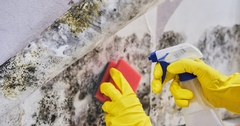
Discovering mold in your home can be unsettling. Mold not only poses health risks but can also damage your property. While some minor mold issues can be addressed through DIY removal, it's essential to understand the limits of what's safe and effective. In this blog post, we'll explore DIY mold removal strategies, discuss when it's appropriate to tackle mold on your own, and when you should call in the professionals for a safer and more thorough remediation.
The Importance of Mold Removal
Mold is a type of fungus that can grow in damp and humid environments. When left unchecked, mold can quickly spread and cause health problems, including respiratory issues, allergies, and skin irritation. Mold can also damage the structure of your home and its contents, leading to costly repairs. Addressing mold promptly is crucial to safeguarding your health and property.
When to Consider DIY Mold Removal
Small, Isolated Areas
If you discover mold growth in a small, isolated area, such as a patch on a bathroom tile or a bit of mold around a window frame, you may be able to address it yourself. Ensure you wear proper protective gear, including an N95 respirator mask, gloves, and safety goggles.
Non-Porous Surfaces
Mold is easier to remove from non-porous surfaces like tile, glass, and metal. If the mold hasn't penetrated the material's surface, you can typically clean it effectively.
Minimal Health Risks
If you're in good health and not particularly sensitive to mold, and the affected area is small and not producing mycotoxins (toxic molds), you may consider DIY removal. However, always monitor your health during the process and seek medical attention if you experience adverse reactions.
DIY Mold Removal Steps
When tackling mold removal on your own, follow these steps for a safe and effective process:
Isolate the Area: Seal off the affected area to prevent mold spores from spreading to other parts of your home. Use plastic sheeting and tape to create a barrier.
Protect Yourself: Wear protective gear, including an N95 respirator mask, gloves, safety goggles, and disposable coveralls.
Ventilate: Open windows and use fans to create proper ventilation in the area. This helps disperse mold spores and reduces exposure.
Moisten the Mold: Lightly mist the moldy surface with water to minimize the release of spores during cleaning.
Clean with Detergent: Use a detergent solution (mix a few drops of mild dish soap in water) to clean the mold off the surface. Scrub gently with a brush, rinse with clean water, and dry thoroughly.
Dispose of Materials: Carefully bag and dispose of any materials, like cleaning cloths or brushes, used in the cleaning process.
Prevent Future Growth: Address the source of moisture that led to mold growth, such as leaks or inadequate ventilation, to prevent recurrence.
When to Call Mold Removal Professionals
Extensive Mold Growth
If the mold problem covers a large area (typically more than 10 square feet), it's best to call professionals. DIY methods may not effectively address extensive mold growth.
Hidden Mold
Mold often thrives in hidden or hard-to-reach areas, such as inside walls, beneath flooring, or within HVAC systems. Professionals have the tools and expertise to locate and remediate hidden mold.
Health Concerns
If you or your family members experience severe allergic reactions, respiratory issues, or other health problems related to mold exposure, it's crucial to consult professionals who can assess the situation and implement safe removal practices.
Structural Damage
Mold can compromise the structural integrity of your home, particularly when it affects materials like drywall, wood, or insulation. Professionals can assess the extent of the damage and provide comprehensive remediation.
Toxic Mold
Toxic molds like Stachybotrys chartarum can produce mycotoxins that are harmful when inhaled or touched. If you suspect toxic mold, it's essential to seek professional assistance for safe removal.
Benefits of Professional Mold Removal
Calling in professionals for mold removal offers several advantages:
Expertise: Mold removal experts have the knowledge and experience to assess the situation accurately, identify the type of mold, and implement the most effective remediation methods.
Safety: Professionals follow stringent safety protocols to protect themselves, your family, and your property during mold removal.
Thoroughness: Experts are equipped with advanced tools and techniques to ensure thorough mold removal, including addressing hidden mold.
Prevention: Professionals can identify and address the root causes of mold growth, such as leaks or poor ventilation, to prevent future infestations.
Health Protection: Mold removal experts can minimize the risk of mold-related health issues by safely containing and removing mold.
While DIY mold removal can be effective for small, isolated areas, it's essential to recognize the limits of what's safe and practical. When dealing with extensive mold growth, hidden mold, toxic mold, structural damage, or health concerns, it's advisable to seek professional mold removal services. Professionals bring expertise, safety, thoroughness, prevention measures, and health protection to the remediation process, ensuring a safer and more effective outcome. Prioritize your health and the well-being of your home by making an informed decision about when to tackle mold removal yourself and when to call in the professionals.